Brotherhood among Irishmen? The Battle of Wijtschate-Messines Ridge, June 1917
Published in 20th-century / Contemporary History, Features, Issue 5 (Sep/Oct 2007), Volume 15, World War I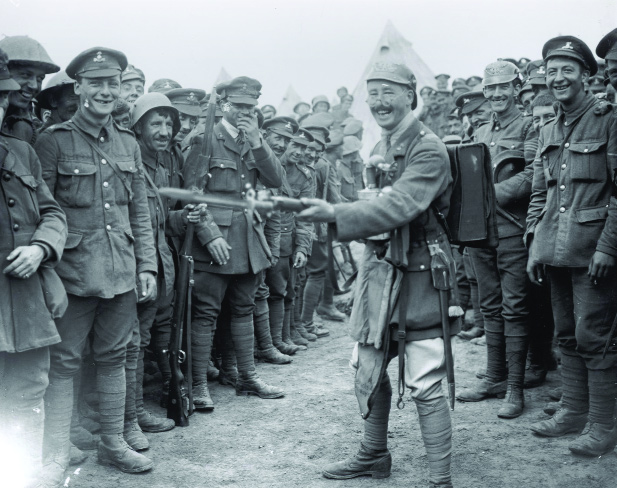
Royal Dublin Fusiliers celebrating their victory at Wijtschate, June 1917. (Imperial War Museum)
Wijtschate-Messines Ridge was a battle that some believed presented an opportunity for reconciliation between the two political traditions in Ireland—British unionism and Irish nationalism. If Irishmen could fight and die together, surely they could live together. The symbolism was not lost on politicians, particularly nationalists. In December 1916, Willie Redmond MP wrote to his friend Sir Arthur Conan Doyle:
‘There are a great many Irishmen today who feel that out of this war we should try to build up a new Ireland. The trouble is, men are so timid about meeting each other half way. It would be a fine memorial to the men who have died so splendidly, if we could, over their graves, build a bridge between north and south.’
Thiepval in July 1916 and Guillemont and Ginchy in September were the graveyards of the original Irish brigades from the 36th (Ulster) and 16th (Irish) Divisions who left Ireland between July and September 1915. Thousands of those idealistic Irish men who joined up in the first few months of the war died near these French villages during the Somme campaign. Following that terrible ordeal, the 36th (Ulster) and 16th (Irish) Divisions left the Somme sector in late July and September respectively and moved north to the relative calm of the Flanders line facing German-occupied Wijtschate. There they relieved the Canadian troops who had held this sector of the front prior to their arrival. When they arrived, the Germans, using signs put up along their front line, actually welcomed the Irish troops.
Part of Plumer’s Second Army
In their move north, both the 16th (Irish) and 36th (Ulster) Divisions became part of General Sir Herbert Charles Onslow Plumer’s Second Army. The winter of 1916/17 around the villages of Loker and Dranouter in western Flanders, where the Irish soldiers were based, was appalling. Initially many of the soldiers had to live in tents because there were not enough billets for all the troops. During the months of March, April and May both divisions underwent a period of intense training in preparation for the attack on Wijtschate. The days of marching men towards well-defended German machine-gun positions, as had happened at the Somme, were over. The British Army had learned a bitter lesson, at a terrible cost in human life. When the men were not training, they assisted in the massive infrastructural work that was undertaken prior to the attack on Wijtschate. New roads were built; light gauge railway lines were laid from the reserve areas near the front line to bring supplies up and carry the wounded back. They also conducted raids on the German lines to gain intelligence. The one feature of this battle that stands out above others on the Western Front prior to June 1917 was the amount of training, planning and preparation insisted on by General Plumer and his staff.
There may have been sound reasons why these two divisions were put alongside each other in the late summer of 1916. One possible motive was recruitment in Ireland—or, more precisely, the lack of recruitment. After the Somme, recruitment had dropped off drastically all over the British Isles, and Ireland was no different in that regard. Between 1914 and 1916 recruitment in Ireland dropped from c. 50,000 per annum to c. 9,000. By 1917 it had fallen further to c. 8,000. The adjutant general, Sir Nevil Macready, presented several solutions: the introduction of conscription; the amalgamation of the 16th (Irish) and 36th (Ulster) Divisions; the reinforcement of Irish units with English conscripts, allowing the divisions to waste away; and the transfer of Irish troops from non-Irish units to Irish formations. The army council opted for the second proposal, the amalgamation of the 16th and 36th Divisions.
General Nugent, the commander of the Ulster Division, thought that the amalgamation of the two Irish divisions would work. By the end of the war, all four solutions had been tried out, in one way or another. During the debate on the second solution, politics raised its head. John Redmond came to the conclusion that amalgamation was unnecessary, and Edward Carson proposed that the 36th (Ulster) Division should be amalgamated with the Scottish 51st (Highland) Division. In the end no amalgamation took place and a compromise solution was reached: men recruited in Ireland would go to regular Irish battalions, while English drafts would be used to maintain Irish service battalions. Those who made the decision to place the two Irish divisions side by side in the same corps facing the Germans in Wijtschate believed that by doing so they would create a sense of Irish and Ulster pride back home, which (they hoped) would have a positive impact on recruiting.
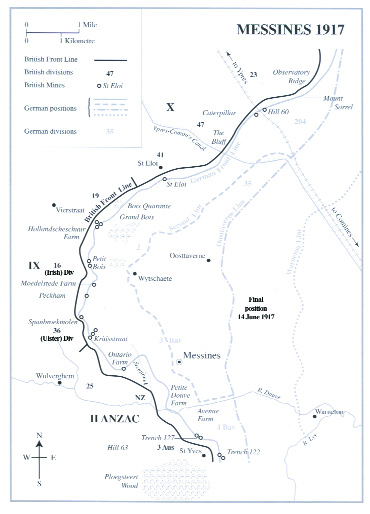
Battle lines for attack on Wijtschate, 7–14 June 1917.
The move kept some politicians happy, particularly those in the Irish Parliamentary Party. On this particular theme, Willie Redmond MP wrote to a friend in Ireland just after his final return to the front:
‘I wish I had time to write you all I have seen out here. My men are splendid and are pulling famously with the Ulster men. Would to God we could bring this spirit back with us to Ireland. I shall never regret I have been out here.’
How did they get on?
Redmond’s reference to his men ‘pulling famously with the Ulster men’ is worthy of closer analysis. Was this true? What, in fact, was the relationship between the men from the 16th (Irish) and 36th (Ulster) Divisions during their time together? There were many occasions when they came into contact with each other around the villages of Loker, Dranouter, Kemmel and Bailleul. For example, on Saturday 26 May 1917 the divisional band of the 16th (Irish) Division put on a concert in Loker for all to attend, and many of the 14th Royal Irish Rifles, the Young Citizen Volunteers (a unit of the UVF) from the Ulster Division, attended the show. There they met and mixed with men from the 16th (Irish) Division. There were no reports of any disturbances. Another meeting place was in the town of Bailleul, just over the border in France. Most of the Irish troops serving around the region went to Bailleul for a bit of entertainment. Known to the Irish soldiers as ‘Ballyhooly’ after the town in Cork where some of them trained, it was the railhead of the line from St Omer and Boulogne.

Lt. Dick Burke MC, 3rd and 6th Royal Irish Regiment, from Dingle, Co. Kerry, fought at Wijtschate in June 1917. He also fought in the Easter Rising in 1916 and is pictured here (extreme right, standing) in front of the Parnell monument with a group of British Army officers. Note the captured Sinn Féin flag taken from the GPO.
One of the Ulster Division camps near Bailleul was named the Shankill Camp; there was another camp not too far away named Celtic Park. Bailleul had shops and an ordnance store, a few hotels, restaurants and a club for officers. It also had its own special attraction for the Irish soldiers, as Lt. May of the 49th Machine Gun Company noted:
‘The special attraction of the town was a girl called Tina. Everyone in the area had heard of her . . . she was the best known girl outside Paris . . . she was a fine good-looking girl and I think a decent girl. She spoke good English and was a barmaid at a café in the town. She had innumerable proposals from English officers “including two generals”. Before the attack on Wijtschate, Tina was removed from Bailleul, for it was thought that she had too much knowledge of our troop movements.’
Despite all the training and preparatory work carried out by the men from the Irish divisions in the months leading up to the attack on Wijtschate, there was still time for a spot of football, which was a great pastime around Loker. Matches were played between battalions and, more interestingly from an Irish perspective, between divisions.
On the afternoon of Saturday 21 April, the 9th Royal Irish Fusiliers (the ‘Faughs’), a battalion of the Ulster Division’s 108th Brigade, played a football match against the 2nd Royal Dublin Fusiliers in Loker. The Faughs must have been a decent side because they beat the Dubs 7–0. Four days later they beat the 6th Connaught Rangers 2–0. A couple of days before returning to the line on 5 May, the 47th Brigade of the 16th (Irish) Division held a sports day. These sports days were always good for morale. On 29 April, the 6th Connaught Rangers played a football match against what Roland Fielding described as a battalion ‘of the Carson (36th) Division’. The team they played was in fact the 9th Royal Irish Fusiliers.
At the second match, which for the Ulstermen was unusual insofar as it was played on the Sabbath, a crowd of up to 3,000 spectators was reported. The large attendance caused Col. Fielding some concern. Such a concentration of troops offered a prime target to German artillery if they got wind of the match. Knowing something about the politics of Ireland and the interest this match had aroused, however, Col. Fielding’s heart ruled his head on this occasion and he allowed the match to go ahead. It would have taken a brave man to cancel it, German artillery or not. A wag on the Ulster side was heard to say: ‘I wonder if we shall get into trouble for fraternising with the enemy?’ For the record, the Faughs again beat the Rangers 2–0.
There were examples of both good and bad relationships between the divisions. Walter Collins was a Londoner who served in the 9th Royal Irish Rifles. With a fine bit of political correctness, he referred to his battalion being with the ‘Irish (Ulster) Division (36th)’. He noted in his diary:
‘For identity in the field we wore a shoulder flash, an orange shaped symbol or tab to denote our association as Orangemen . . . Being practically politically unconscious at that time I found it very difficult to understand their antagonisms of religious belief, etc. which at times boiled up, but if they fought each other on occasion there was never any doubt whose side they were on in relation to the common enemy or of their courage in action whatever part of Ireland they came from.’
In As from Kemmel Hill (London, 1963) Andrew Behrend wrote on this relationship:
‘I should like to put on record one further memory of the Battle of Messines. However little it interested me then, it fascinates me today; that during the battle and for the weeks before, the 16th (Irish) and the 36th (Ulster) Divisions lived and fought side-by-side, got on with each other splendidly and at times even pulled each other’s chestnuts out of the fire.’
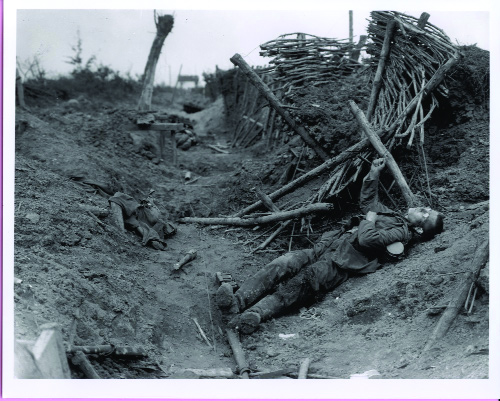
A dead German soldier near Messines. (Imperial War Museum)
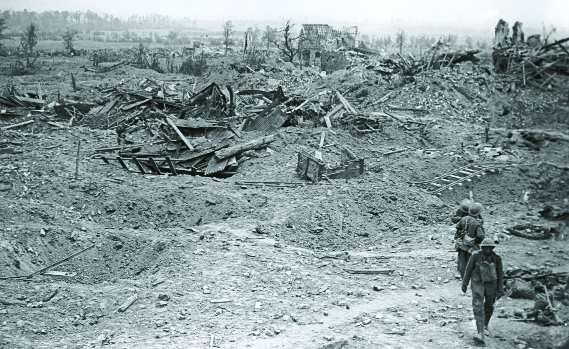
The village of Wijtschate after the attack. (Imperial War Museum)
On 20 November 1915, Pte Joseph Elley of the 2nd Royal Dublin Fusiliers wrote home to Monica Roberts, thanking her for the latest food parcel she had sent him. The weather then was freezing hard:
‘Well, we are having a time, its simply heartbreaking to see such strong and good boys getting frost bitten . . . We have the Ulster Division with us at present and fine good lads they are, good old Ireland again. The Dublins get on with all the regiments, especially the Jocks and on the whole its great to be out here knowing you are defending your own at home.’
Later on, in early December, Elley wrote to Miss Roberts again: ‘I suppose you saw in the papers about Redmond’s visit to the front. I might say he spoke to the Ulster men and there is no bad feeling amongst us fellows out here and I think it will end such feelings forever.’
Revd John Redmond CF was a Church of Ireland chaplain attached to the 9th Royal Inniskilling Fusiliers during their time facing Wijtschate. On the relationship between men from both divisions he wrote:
‘It was impressive to see what a feeling of security before the battle the Ulster Division had in having the 16th Irish on our left flank and that the 16th Division had in having our Ulster Division on their right flank. This feeling of goodwill and confidence between the two divisions had been growing for some time. I wish the entire north and south that they represent, could participate in the same spirit.’

Men from the Royal Inniskilling Fusiliers and Royal Irish Rifles celebrating their victory at Wijtschate, June 1917. Note the YCV flag (Young Citizen Volunteers, youth section of the Ulster Volunteer Force). (Imperial War Museum)
Captain Stephen Gwynn, a nationalist officer in the 6th Connaught Rangers, wrote to his cousin Amelia on St Stephen’s Day (26 December) 1916: ‘We are alongside the Ulster Division and making great friends with them—which is well’. Many months after the attack on Wijtschate, The Galway Observer (21 September 1918) recorded the following:
‘In a letter to the mayor of Derry (Mr R. N. Johnston) on Irish achievements in the war, Capt. Gwynn recalls that he saw Derrymen at a place where, “there was no thought of anything but our common credit” on the ridge in front of Messines, where the 16th and 36th Divisions lay side by side. “Once it happened”, he says, “that our right flank was moved up a little and I was the officer sent up to take over the section of the line from the Ulster troops who were holding it. They were the Inniskillings, and the commanding officer, Colonel McRory, showed me round the line. All the trenches had names that were very familiar to me, but at last we came to a very strong point at the head of a mineshaft, where there was a great accumulation of sandbags. Col. McRory said to me rather sadly: ‘We call this place Derry Walls, but I suppose that when your fellows come in here they will be changing all the names’. I said to him: ‘we won’t change a name of them, and we will hold Derry Walls for you’. We did hold Derry Walls for four months and gave it back to the Ulster people and it was from there they went over the top on that day, when the two divisions, side by side, captured Messines and Wytschate”.’
Once battle commenced, at 3.10am on 7 June 1917, the planned objectives were achieved within hours and on schedule. The mines and a massive and very detailed combination of creeping and standing artillery barrages followed by consolidation and reinforcement removed the Germans from Wijtschate and off the Wijtschate-Mesen Ridge by mid-morning. During the late evening of 7 June, like many of the unit commanding officers, Major Boyle of the 150th Field Company took a walk up front to inspect the consolidation work his men were doing. He found some of his men working beside and in cooperation with men from the Royal Munster Fusiliers:
‘Number 1 Section I found had not been able to start work owing to hostile shelling. Lt. Thorne was just starting them in conjunction with 16th Division Royal Munster Fusiliers. So Ulster and the South of Ireland consolidate a position. The Orange and Green working together and blended well.’
In contrast to these examples, relations between the men of the 16th (Irish) and 36th (Ulster) Divisions were not always so cordial. Fr Henry Gill SJ was a chaplain with the 2nd Royal Irish Rifles, who were transferred in to the 36th (Ulster) Division after the Battle of Wijtschate. This particular battalion of the Royal Irish Rifles was a regular battalion with a large component of Catholic soldiers from Cork and Dublin. The move, he noted, ‘came as a surprise and a disagreeable shock almost to everyone’. Lt.-Col. Denys Reitz, the commanding officer of the 7th Royal Irish Rifles of the 48th Brigade, 16th (Irish) Division, recalls how he and a few of his men prevented a fight between some of his men and ‘the bloody Orangemen’ from the Ulster Division. Lt. Percy McElwaine of the 14th Royal Irish Rifles recalled an incident, which was probably no more than a bit of banter:
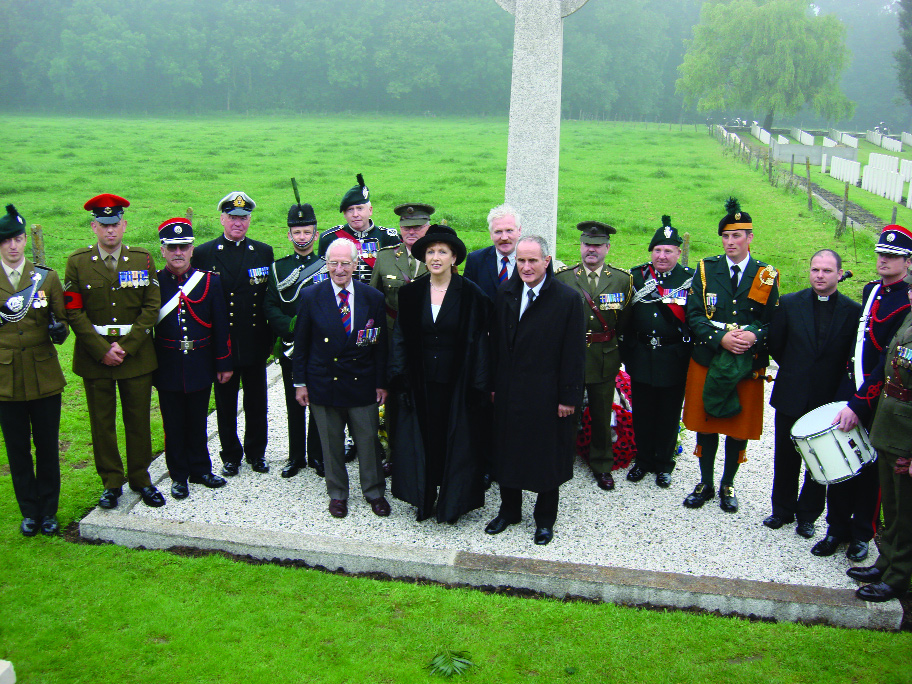
President Mary McAleese at the foot of the 16th (Irish) Division’s cross in Wijtschate in June 2007.
‘On one occasion there was a slight adjustment of our front near Wulverghem. A battalion of the Dublin 16th (Irish) Division took over from one of our battalions. I think indeed from the YCVs. As the Dublins came in, one of them remarked, “Glory be to God will you look at the Carson’s Boys”. From whom there was a reply, “Get the Hell out of that you bloody Fenians”.’
The relationship between the men from the 16th and 36th Divisions in Flanders may well have reflected what was happening back home in Ireland at the time. There were UVF men in the 36th (Ulster) Division and there were National Volunteer men in the 16th (Irish) Division. These were two diametrically opposed armed political militias who would have killed each other had it not been for the outbreak of the war. When faced with a common enemy, however, despite their ethnic or religious differences, it would seem that they did indeed pull each other’s chestnuts out of the fire. The enemy that faced Carson’s men in Wijtschate were the Saxons and East Prussians, not the Dubliners or Corkonians beside them. The same could be said for the Redmondites in the 16th Division.
At 3.10am on Thursday 7 June 1917, two infantry divisions of the British Army raised in Ireland fought side by side and defeated a common enemy. For a while, at least, old quarrels were set aside. Willie Redmond dreamed of building a new Ireland, a nation at peace with itself and its neighbours. The wonderful events at Stormont Castle in May 2007 show that sometimes dreams do come true.
Tom Burke MBE is chairman of the Royal Dublin Fusiliers Association.
Further reading:
T. Burke, The 16th (Irish) and 36th (Ulster) Divisions at the Battle of Wijtschate-Messines Ridge, 7 June 1917: a battlefield tour guide (Heuvelland, 2007).
I. Passingham, Pillars of Fire—the Battle of Messines Ridge, June 1917 (London, 1998).
Further reading:
















